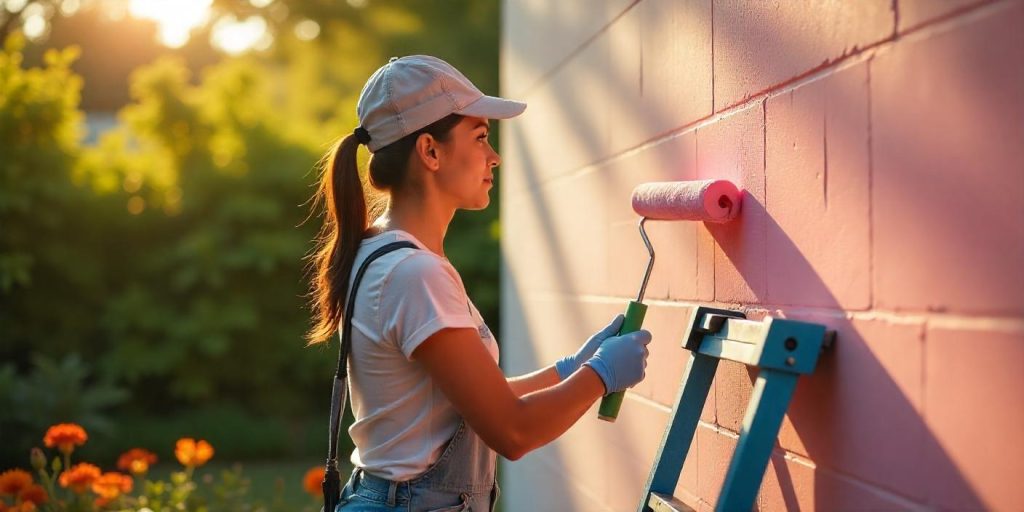Painting masonry walls is a rewarding project that adds value, protection, and style to your property. Whether you’re tackling interior walls in a basement or revitalizing exterior walls exposed to the elements, painting masonry requires specific techniques and materials to ensure long-lasting results.

This in-depth guide covers everything you need to know, from preparation to the best painting methods for masonry walls.
Contents
- Benefits of Painting Masonry Walls
- Preparing Masonry Walls for Painting
- Choosing the Right Paint for Masonry Walls
- Tools and Materials Needed
- Painting Masonry Walls: Step-by-Step
- Different Techniques for Painting Masonry
- Tips for Exterior Masonry Walls
- Maintenance of Painted Masonry Walls
- Common Mistakes to Avoid
- Conclusion
Benefits of Painting Masonry Walls
Enhanced Aesthetic Appeal
Painting masonry allows you to customize the look of your space, whether you’re aiming for a sleek modern finish or a rustic charm.
Increased Durability
A good paint job protects masonry surfaces from weather, moisture, and wear, prolonging their lifespan.
Moisture Protection
Specialized masonry paints can seal pores, preventing water infiltration and reducing issues like mold or mildew.
Preparing Masonry Walls for Painting
Preparation is the foundation of a successful paint job. Skipping these steps can lead to peeling, cracking, or uneven results.
Cleaning the Surface
Dirt, grime, and previous coatings can interfere with paint adhesion.
- Exterior Walls: Use a pressure washer to clean the surface thoroughly.
- Interior Walls: Scrub with a stiff-bristle brush and a mixture of water and mild detergent.
Allow the surface to dry completely before moving on to the next step.
Checking for Damage
Inspect the masonry for:
- Cracks: Fill these with masonry filler and allow them to dry.
- Loose Mortar: Repoint the joints to stabilize the structure.
- Efflorescence: Remove white salt deposits with a wire brush or a vinegar solution.
Priming the Walls
Priming is crucial for masonry because the porous surface can absorb paint unevenly.
- Choose a primer designed specifically for masonry.
- Apply with a roller, brush, or sprayer, ensuring even coverage.
- Allow the primer to dry fully, following the manufacturer’s instructions.
Choosing the Right Paint for Masonry Walls
Types of Masonry Paint
- Acrylic Latex Paint
- Suitable for interior and exterior use.
- Offers excellent durability and coverage.
- Elastomeric Paint
- Highly flexible and resistant to cracking.
- Ideal for exterior walls and areas prone to moisture.
- Silicate Mineral Paint
- Breathable and long-lasting.
- Best for older masonry and historic buildings.
- Epoxy Paint
- Provides a tough, durable finish.
- Often used for floors but can be applied to walls in high-traffic areas.
Choosing the Right Finish
- Matte: Ideal for hiding imperfections.
- Satin: Offers a subtle sheen, suitable for indoor and outdoor use.
- Glossy: Provides a high-shine look but highlights surface flaws.
Tools and Materials Needed
Tools
- Paint rollers and brushes
- Paint sprayer (optional)
- Drop cloths and masking tape
- Wire brush or scraper
- Pressure washer
Materials
- Masonry primer
- Masonry paint
- Crack filler or mortar repair compound
- Cleaning solution or detergent
Painting Masonry Walls: Step-by-Step
Step 1: Preparing the Area
- Remove furniture, plants, or obstacles near the wall.
- Protect surrounding surfaces with drop cloths or plastic sheeting.
- Mask off edges and trim with painter’s tape.
Step 2: Cleaning the Walls
Ensure the walls are free from dirt, debris, or previous paint flakes. For stubborn stains, consider using a degreaser.
Step 3: Priming the Surface
Apply a masonry primer using a roller or sprayer. Cover all areas evenly and let it dry as recommended by the manufacturer.
Step 4: Applying the Paint
- Brush and Roller Method: Use a roller for larger areas and a brush for edges and corners. Apply thin coats, letting each dry before the next.
- Sprayer Method: Spray in consistent, overlapping strokes. This method works best for large exterior walls.
Step 5: Inspect and Touch Up
Once the final coat is dry, inspect the wall for missed spots or uneven areas. Touch up as needed with a brush.
Different Techniques for Painting Masonry
Limewashing
Limewashing involves applying a mixture of lime, water, and pigment for a breathable, matte finish. It’s ideal for older masonry and creates a natural, weathered look.
Stenciling and Patterns
Use stencils to create unique patterns on masonry walls. This adds character to interior spaces or garden walls.
Sponge Painting
For a textured, multi-tonal finish, use a sponge to dab different shades onto the wall. This technique works well for accent walls.
Tips for Exterior Masonry Walls
Weather Considerations
- Avoid painting in extreme temperatures or high humidity.
- Ensure the walls are dry after rain before starting.
Sealing the Paint
Apply a clear sealer over the paint for additional protection against weather and UV rays.
Preventing Mold and Mildew
Choose a paint with mold-resistant properties, especially in damp climates.
Maintenance of Painted Masonry Walls
Regular Cleaning
Dust and dirt can dull the finish. Clean exterior walls annually with a pressure washer and interior walls with a damp cloth.
Retouching
Inspect walls regularly for chips or cracks and retouch as needed to maintain their appearance.
Common Mistakes to Avoid
- Skipping primer: Leads to uneven paint absorption.
- Using the wrong paint type: Reduces durability and adhesion.
- Painting over dirty surfaces: Causes peeling and flaking.
- Applying thick coats: Results in drips and an uneven finish.
Conclusion
Painting masonry walls is a transformative project that requires careful preparation, the right materials, and attention to detail. Whether you’re enhancing your home’s interior or boosting curb appeal with exterior walls, this guide provides the knowledge to achieve a professional, durable finish.
By choosing the right paint and applying it correctly, your masonry walls will stay beautiful and protected for years to come.
